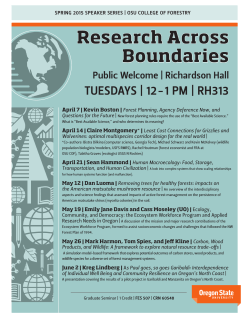
Kenai`s changing fire regime
The Future of Wild Land Fires on the Western Kenai Peninsula Mitch Michaud, CF USDA-NRCS Scott Rupp credit A New Forest? with a New Fire Risk! • - Fires will be more frequent • - Grass will be the new fire threat on the peninsula • - White Spruce and Birch may not be the dominate vegetation • - A woodland/grassland fire regime may perpetuate itself • - What can we do…… ? Is this really an issue……….? Robert Purcell…….. Homer Fire Chief, 1999 retired ‘I was a firefighter in California before I moved to Homer…. There are 3 things in the woods that could kill you… - A brown bear - A forest fire - A wild land grass fire Which one are you most likely survive? Which the least?’ More Robert Purcell……1999…… • The Kenai is different than it was in in 1990 C New and Old Data, New Regions July High Temperatures March High Temperature May High Temperature Compare March to May June to August Compare Rain Fall U.S. fire causes AK fire causes Alaska 2014 Debris Burning 25% Misc. 25% Campfires 17% Lightning 14% Undetermined and Arson 7% Equipment 5% Incendiary 5% 86% of fires are human caused in Alaska. 98% of fires are human caused in the U.S. Lightning Lightning 2014 - 5 days with 3000 + Strikes. State wide Alaska Fire Service using new lightning detection system 2012 New lightning detection Anchorage 2008 Anchorage and Fairbanks(airports) Anchorage averages 1 thunder storm per year Fairbanks averages 8 per year Will Lightning increase on the Kenai Peninsula? Orographic Thunder Storms Lighting Strikes on the Kenai - Skilak Area… Mystery Hills …. Caribou Hills…. Homer Bench???? Here is why lighting maybe increasing1. General Warming Temperature….. 1 Degree enough to make a difference? How about changing the vegetation. 1. …….. Forestland average high temperatures 50 F for hardwoods 60 F for soft woods 1. ……….Grassland average high temperatures 90+ F 2. ……….Clearcuts can increase high temperatures by 40 F (110 F) 3. ……….Burned sites can increase high temperatures by 50 F ( 120F) Large changes in Vegetation - 1.2 million acres of infested spruce forest - 95,000 acres of timber harvesting (ADF&G) - 190,000 acres of fire in 2014 Are we on the edge of permanent change? Life: The Science of Biology, 4th Edition, by Sinauer Associates Trees and Grass Trees - Spruce and Birch • Spruce and Birch are easily killed by fire for the 1st 30 years of growth • AK.. I’d say 40 years. The first 10 are spend working against the grass and moose • Its takes about 40 years for a site become fully stocked-occupied by trees (E. Berg, Chikaloon SBB historical stands comparison) • Heavy grass competition in SBB stands delays full stocking by 40 yrs. (L.Tummer, USFS Cooper Landing) -For Reference a 30 year old tree in Soldotna is about 25 feet tall, is about 6 inches in diameter at 4.5 feet above the ground and has green branches to the ground if it is open grown, and has grass and shrubs growing around and into it. The Grass,…… it is all about the Grass, - Its called - Calamagrostis canadensis Bluejoint Reed Grass. Joint Grass, aka Canada Blue Joint Grass, PLANT RESPONSE TO FIRE : Following low-severity fires, bluejoint reedgrass will typically sprout from on-site surviving rhizomes. Buried or wind-dispersed seeds may be the primary source of plant establishment on severely burned sites PLANT RESPONSE TO FIRE : Following low-severity fires, bluejoint reedgrass will typically sprout from on-site surviving rhizomes. Buried or wind-dispersed seeds may be the primary source of plant establishment on severely burned sites DISCUSSION AND QUALIFICATION OF FIRE EFFECT : Under droughty conditions dead shoots of bluejoint reedgrass exhibit low moisture content. In small experimental fires in Inuvik, Northwest Territories, dead litter sustained combustion, but the fire merely burned around the live material A Perpetual cycle of grass and fire Excerpts from USDA Forest Service Fire Reference Summaries Starfield and Chapin estimated a fire-return interval of 40 years in dry grasslands in boreal regions of Alaska, based on the assumption that Alaskan dry grasslands have a higher fire frequency than other ecosystem types in the same region. Researchers studying dry grasslands in northwestern British Columbia stated that fires occurred more frequently and were more variable in size, seasonality, and severity in grasslands than in surrounding forests or wetlands. Because the fire-return interval was assumed to be short (10 years), the dry grassland persisted indefinitely, resulting in permanent increases in fire frequency in both dry grassland and adjacent communities What can we do…… short term….. Prepare to live with fire at the homeowner level. Reduce Debris Burning Brush Dump Site- Cohoe Fire Breaks Will Prevent Forest Wild Land Fires! - Education - 85% of fires are human caused - Get rid of the shovel - Have him loose some weight - Put him in running shoes - Make sure he has an iPhone……. - Make him look like a real Kenai Brown Bear Long Term Fixes --- can we really live with fire - Restore the old forest - Establish a new forest type - Do nothing grass/ woodlands A New Forest - Can we replant the spruce forest? - Can we replant with birch? about the moose? - What would the new species be? - Are we willing to wait 40 to 50 years - Can we remove / control the grass Start with Outside the Box Thinking
© Copyright 2025














